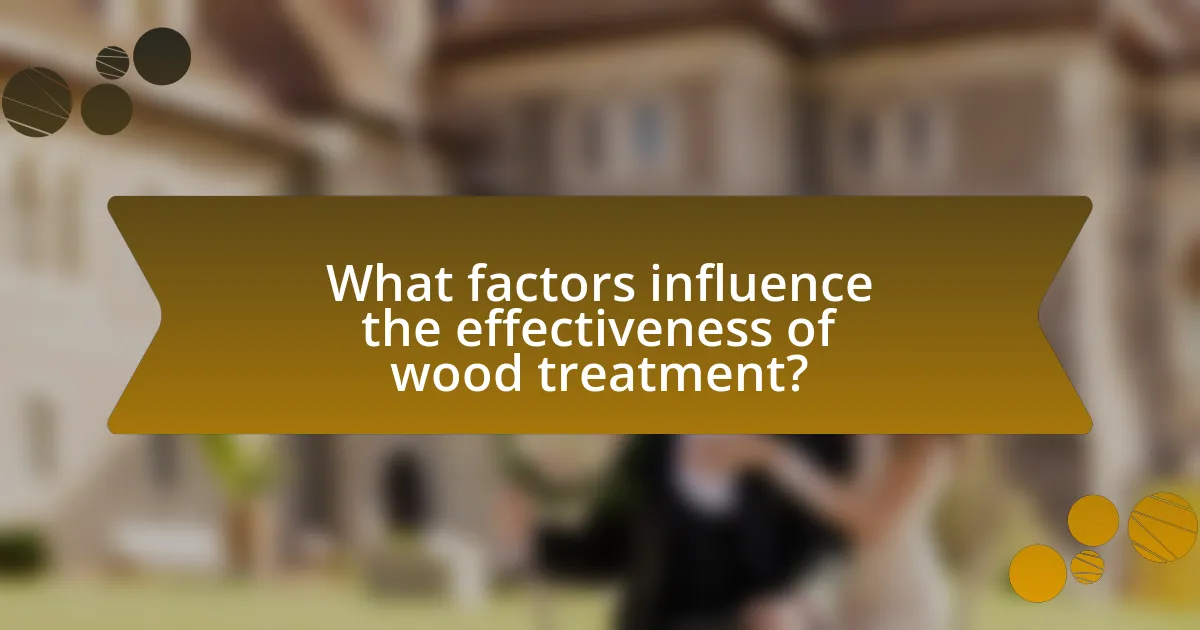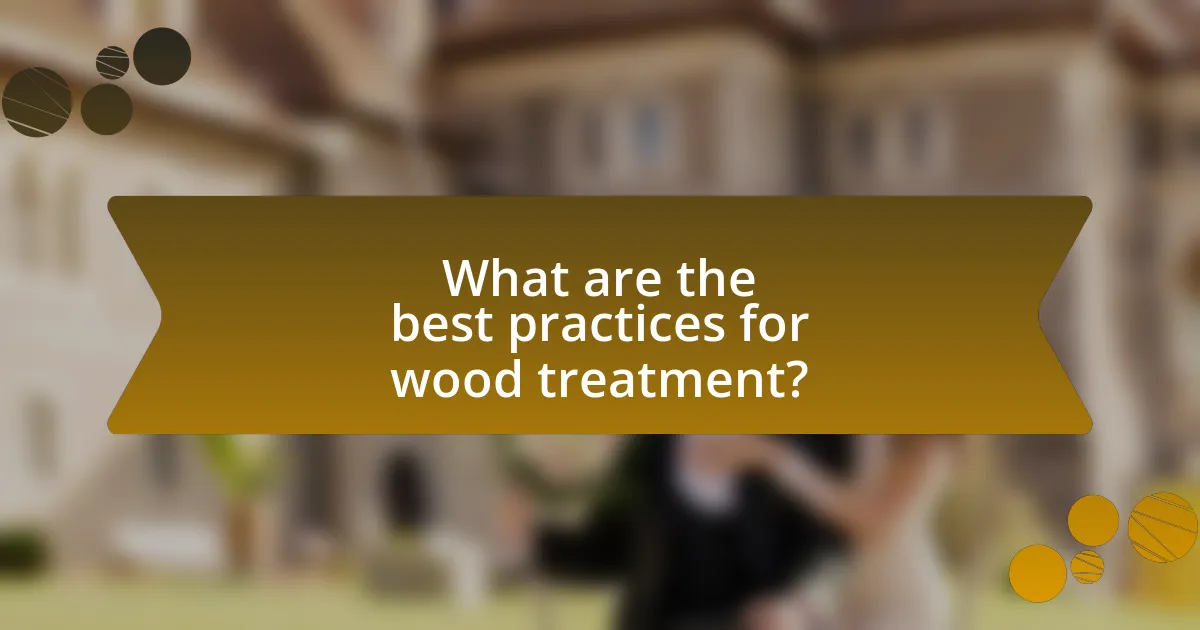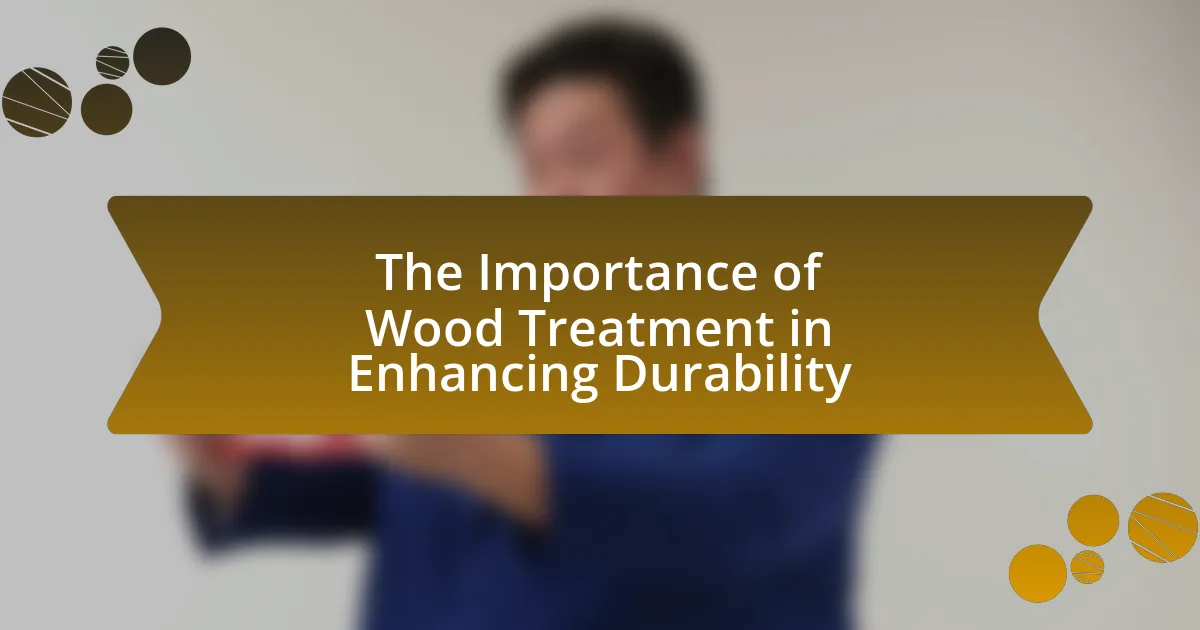Wood treatment is essential for enhancing the durability and longevity of wooden structures by protecting them from decay, pests, and environmental damage. Various treatment methods, including pressure treatment, chemical preservatives, and natural oils, significantly improve wood’s resistance to moisture and insects, thereby extending its lifespan. The article explores the types of wood treatments available, their impact on physical properties, and the best practices for application and maintenance. Additionally, it addresses the factors influencing treatment effectiveness, common challenges, and the importance of regular evaluations to ensure the continued durability of treated wood.

What is the Importance of Wood Treatment in Enhancing Durability?
Wood treatment is crucial for enhancing durability as it protects the material from environmental factors, pests, and decay. Treated wood can resist moisture absorption, which prevents warping and splitting, thereby extending its lifespan. For instance, pressure-treated wood can last up to 40 years or more when properly maintained, compared to untreated wood, which may only last a few years in similar conditions. This significant difference underscores the importance of wood treatment in ensuring structural integrity and longevity.
How does wood treatment contribute to the longevity of wooden structures?
Wood treatment significantly enhances the longevity of wooden structures by protecting them from decay, pests, and environmental damage. Treatments such as pressure treatment with preservatives, sealants, and finishes create a barrier that prevents moisture absorption, which is a primary cause of wood rot. For instance, studies show that pressure-treated wood can last up to 40 years or more in outdoor applications, compared to untreated wood, which may only last a few years. Additionally, wood treatments can inhibit the growth of fungi and deter insects like termites, further extending the lifespan of wooden structures.
What types of wood treatments are available for enhancing durability?
There are several types of wood treatments available for enhancing durability, including pressure treatment, chemical preservatives, and natural oils. Pressure treatment involves forcing preservatives deep into the wood fibers, which protects against rot and insect damage; this method is commonly used for outdoor structures. Chemical preservatives, such as borates and copper-based compounds, provide long-lasting protection against decay and pests, making them suitable for both indoor and outdoor applications. Natural oils, like linseed and tung oil, penetrate the wood and create a water-resistant barrier, enhancing durability while allowing the wood to breathe. These treatments are supported by industry standards, such as those set by the American Wood Protection Association, which validate their effectiveness in prolonging the lifespan of wood products.
How do different wood treatments affect the physical properties of wood?
Different wood treatments significantly alter the physical properties of wood, enhancing its durability and performance. Treatments such as pressure treatment with preservatives, heat treatment, and chemical treatments can increase resistance to moisture, decay, and insect damage. For instance, pressure-treated wood typically exhibits lower moisture absorption, which reduces the risk of warping and splitting, while heat-treated wood shows improved dimensional stability and reduced susceptibility to fungal decay. Research indicates that heat treatment can increase the hardness of wood by up to 25%, demonstrating a clear enhancement in physical properties.
Why is wood treatment essential for various applications?
Wood treatment is essential for various applications because it significantly enhances the durability and longevity of wood products. Treated wood is protected against decay, insect infestations, and environmental factors such as moisture and UV radiation, which can lead to structural failure. For instance, according to the American Wood Protection Association, treated wood can last up to 30 years or more in outdoor applications compared to untreated wood, which may only last a few years. This treatment process not only extends the life of wood but also reduces maintenance costs and improves safety in construction and other uses.
What are the specific benefits of wood treatment in outdoor environments?
Wood treatment in outdoor environments significantly enhances durability by protecting against moisture, pests, and UV damage. Treated wood resists rot and decay, extending its lifespan, which is crucial in outdoor applications where exposure to the elements is constant. For instance, pressure-treated wood can last up to 30 years, compared to untreated wood, which may only last 5 to 10 years in similar conditions. Additionally, wood treatment reduces the risk of insect infestations, such as termites, which can compromise structural integrity. The application of protective coatings also minimizes fading and discoloration caused by UV rays, maintaining the aesthetic appeal of outdoor structures.
How does wood treatment impact the maintenance of wooden furniture?
Wood treatment significantly reduces the maintenance required for wooden furniture by enhancing its resistance to moisture, pests, and decay. Treated wood forms a protective barrier that prevents water absorption, which can lead to warping and mold growth. For instance, pressure-treated wood is often infused with preservatives that inhibit fungal growth and deter insects, thereby extending the lifespan of the furniture. Studies show that properly treated wooden furniture can last up to three times longer than untreated wood, resulting in lower maintenance costs and less frequent replacements.

What factors influence the effectiveness of wood treatment?
The effectiveness of wood treatment is influenced by several key factors, including the type of wood, the treatment method used, environmental conditions, and the duration of exposure to the treatment. Different wood species have varying densities and natural resistance to decay, which affects how well they absorb treatment chemicals. For instance, hardwoods typically require different treatment approaches compared to softwoods due to their structural differences.
The method of treatment, such as pressure treatment or surface application, also plays a crucial role; pressure treatment often results in deeper penetration of preservatives, enhancing durability. Environmental conditions, including temperature and humidity, can impact the curing process and the longevity of the treatment. Lastly, the duration of exposure to the treatment solution is critical; longer exposure generally leads to better absorption and effectiveness.
Research indicates that these factors collectively determine the overall success of wood treatment in enhancing durability, as evidenced by studies showing that properly treated wood can last significantly longer than untreated wood in similar conditions.
How do environmental conditions affect wood treatment outcomes?
Environmental conditions significantly influence wood treatment outcomes by affecting the absorption and retention of preservatives. High humidity levels can enhance the penetration of treatment solutions, while low temperatures may slow down the curing process, leading to inadequate protection. For instance, studies have shown that wood treated in warmer, more humid environments often exhibits better durability and resistance to decay compared to wood treated in dry, cold conditions. This is because moisture facilitates the chemical reactions necessary for effective treatment, ensuring that preservatives bond properly with the wood fibers.
What role does wood species play in the selection of treatment methods?
Wood species significantly influence the selection of treatment methods due to their varying natural properties, such as density, porosity, and chemical composition. Different species exhibit distinct levels of resistance to decay, insects, and environmental factors, which necessitates tailored treatment approaches. For instance, hardwoods like oak may require different preservatives compared to softwoods like pine, as hardwoods often have tighter grain structures that affect the absorption of treatment solutions. Research indicates that specific treatments, such as pressure treatment or surface coatings, are more effective on certain wood species, enhancing their durability and longevity in various applications.
How does the application technique influence the durability of treated wood?
The application technique significantly influences the durability of treated wood by determining how deeply the preservatives penetrate the wood fibers. Techniques such as pressure treatment allow for deeper absorption of chemicals, enhancing resistance to decay and insect damage. For instance, pressure-treated wood can achieve a penetration depth of up to 90%, compared to surface treatments that may only protect the outer layer. This deeper penetration results in a longer lifespan, as studies have shown that properly treated wood can last over 40 years in outdoor conditions, while inadequately treated wood may fail within a few years.
What are the common challenges associated with wood treatment?
Common challenges associated with wood treatment include moisture absorption, chemical leaching, and uneven application. Moisture absorption can lead to wood swelling, warping, or decay, as untreated wood is highly susceptible to environmental changes. Chemical leaching occurs when treatment solutions wash away, reducing effectiveness and potentially harming surrounding ecosystems. Uneven application can result in inconsistent protection, leaving some areas vulnerable to pests and rot. These challenges highlight the need for careful selection of treatment methods and materials to ensure long-lasting durability of wood products.
What issues can arise from improper wood treatment application?
Improper wood treatment application can lead to significant issues such as reduced durability, increased susceptibility to pests, and moisture damage. When wood is not treated correctly, it may not effectively resist rot, fungi, or insect infestations, which can compromise its structural integrity. For instance, untreated or improperly treated wood can absorb moisture, leading to warping, cracking, or splitting, ultimately shortening its lifespan. According to the Forest Products Laboratory, untreated wood can decay within a few years when exposed to the elements, highlighting the critical need for proper treatment to enhance durability and longevity.
How can one identify signs of ineffective wood treatment?
Signs of ineffective wood treatment include visible decay, discoloration, and the presence of mold or mildew. These indicators suggest that the protective chemicals have failed to penetrate or adhere properly to the wood surface, allowing moisture and pests to compromise the material. Additionally, if the wood feels soft or spongy to the touch, it may indicate internal damage due to inadequate treatment. Regular inspections can reveal these signs, which are critical for maintaining the wood’s durability and longevity.

What are the best practices for wood treatment?
The best practices for wood treatment include selecting appropriate preservatives, ensuring proper surface preparation, applying treatments in suitable environmental conditions, and following manufacturer guidelines for application. Using preservatives like borates or copper-based solutions effectively protects wood from decay and insect damage. Proper surface preparation, such as sanding and cleaning, enhances the adhesion of treatments, ensuring better penetration and effectiveness. Applying treatments in dry weather conditions allows for optimal absorption and drying, which is crucial for long-lasting protection. Adhering to manufacturer guidelines ensures that the treatment is applied correctly, maximizing its protective qualities.
How can one choose the right wood treatment for specific needs?
To choose the right wood treatment for specific needs, one must first assess the environmental conditions and intended use of the wood. For example, wood exposed to moisture requires a treatment that offers water resistance, such as a water-repellent preservative, while wood used in high-traffic areas may benefit from a durable finish like polyurethane. Additionally, understanding the wood species is crucial, as different types of wood absorb treatments differently; for instance, softwoods often require more frequent applications than hardwoods. Research indicates that using the appropriate treatment can extend the lifespan of wood by up to 50%, highlighting the importance of matching the treatment to the specific requirements of the project.
What factors should be considered when selecting a wood treatment product?
When selecting a wood treatment product, factors such as the type of wood, environmental conditions, desired longevity, and specific protection needs must be considered. The type of wood influences how it absorbs treatment; for instance, softwoods may require different products than hardwoods. Environmental conditions, including exposure to moisture, UV light, and pests, dictate the level of protection needed. Desired longevity affects the choice between temporary and long-lasting treatments, with some products offering protection for several years while others may need reapplication sooner. Specific protection needs, such as resistance to mold, mildew, or insects, should also guide the selection process, ensuring the chosen product effectively addresses the intended use and conditions.
How can proper application techniques enhance treatment effectiveness?
Proper application techniques significantly enhance treatment effectiveness by ensuring uniform penetration and adherence of protective substances to wood surfaces. When treatments are applied correctly, they create a more effective barrier against moisture, pests, and decay, which are critical factors in wood durability. For instance, studies have shown that applying wood preservatives using methods such as pressure treatment or vacuum impregnation can increase the lifespan of treated wood by up to 50% compared to untreated wood. This is because these techniques allow for deeper absorption of the treatment, maximizing its protective qualities.
What maintenance practices ensure the longevity of treated wood?
Regular maintenance practices that ensure the longevity of treated wood include cleaning, sealing, and inspecting for damage. Cleaning treated wood surfaces with a mild detergent and water prevents the buildup of dirt and mildew, which can degrade the wood over time. Sealing the wood with a protective finish every few years helps to maintain its resistance to moisture and UV damage. Additionally, inspecting the wood for signs of wear, such as cracks or rot, allows for timely repairs, which can prevent further deterioration. These practices are supported by studies indicating that properly maintained treated wood can last significantly longer than untreated wood, often exceeding 20 years in outdoor applications.
How often should treated wood be re-evaluated for durability?
Treated wood should be re-evaluated for durability every 3 to 5 years. This timeframe allows for the assessment of any deterioration due to environmental factors, such as moisture and UV exposure, which can compromise the wood’s integrity. Regular inspections within this period help identify issues early, ensuring that the treated wood maintains its protective qualities and extends its lifespan.
What are the recommended cleaning methods for maintaining treated wood?
The recommended cleaning methods for maintaining treated wood include using a mild detergent mixed with water, applying a soft-bristle brush to scrub the surface, and rinsing thoroughly with clean water. These methods effectively remove dirt, mildew, and debris without damaging the wood’s protective treatment. Regular cleaning, ideally every six to twelve months, helps preserve the integrity and appearance of treated wood, ensuring its longevity and durability.
